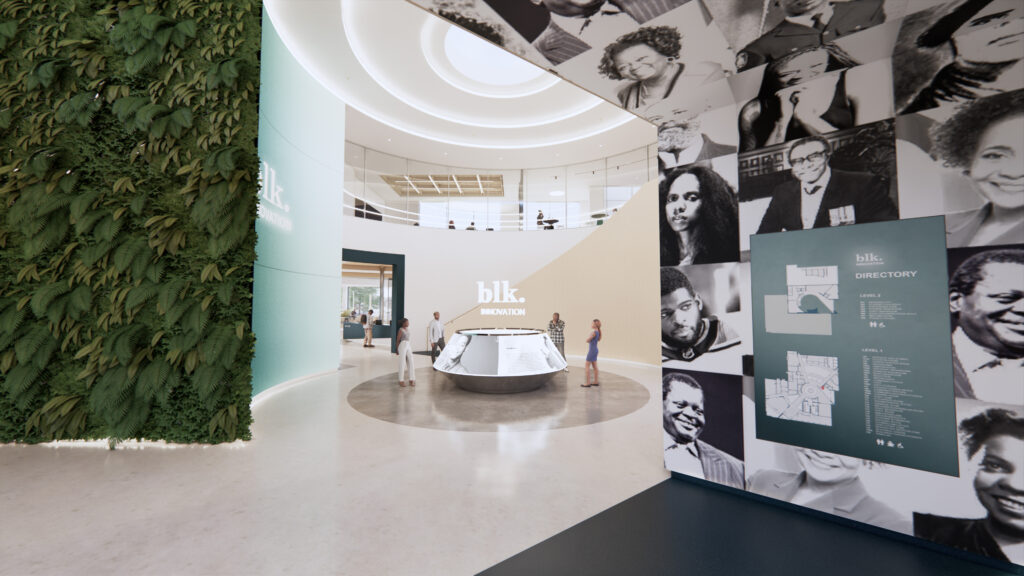BLK Innovation Thesis Project delves into the persistent challenges faced by Black students in higher education, contextualizing their experiences within a history of discrimination and exclusion. Despite efforts towards diversity and inclusion in academic institutions, disparities persist in graduation rates and academic achievement between Black and White students. The lack of supportive environments for Black students in Canadian universities is highlighted, emphasizing the need for thoughtfully designed spaces that foster empowerment, well-being, and a sense of belonging. The study aims to explore interior design solutions to address these issues, focusing on the development of a social and innovation hub tailored for Black students in Toronto.
Through various research methods and theoretical frameworks, the study seeks to enhance the collegiate experience for Black students by creating spaces that promote security, empowerment, community, and celebration of Black culture. The importance of inclusivity, mental well-being, and addressing systemic inequities is underscored, with the personal rationale of the researcher, a Black interior design student, adding depth to the significance of the study in addressing institutional racism and promoting diversity in design education.
Theoretical Framework
The theoretical framework establishes the foundation for the research study, defining the lenses through which the research problem will be examined. It serves to guide the analysis and interpretation of data by focusing on specific variables and theoretical perspectives. The framework includes two main components:
Place Attachment Theory and Trauma-informed Design
Place Attachment Theory explores the emotional and cognitive bonds individuals develop with specific places, beyond mere physical proximity. It encompasses dimensions such as the person, psychological process, and object of attachment, offering a comprehensive understanding of the complex nature of place attachment.
Trauma-informed Design, an emerging concept in architecture, aims to create spaces that promote healing and well-being by applying principles rooted in equity and empathy. This approach draws on trauma-informed care principles, emphasizing safety, respect, community, and dignity in space design.

Reception & Waiting

Central Lobby
"In the blueprint of equity, every line drawn is a bridge between history and hope, where architecture becomes the cornerstone of empowerment, and every space a sanctuary for the resilient voices of tomorrow."
Jhenae Stephens
Scope & Limitations
The scope and limitations of the study clarify the research’s focus, methodology, and potential constraints. While the study aims to develop practical design solutions for a social and innovation hub for Black higher education students in Toronto, it acknowledges limitations such as the restricted timeframe, participant availability, and regional focus. The study employs a mix of interviews, literature review, and case studies to gather insights and inform design decisions, recognizing the importance of ethical considerations and the diverse needs of the Black community.
Findings
The study’s findings encompass a comprehensive examination of key themes pertinent to designing a social innovation hub for Black higher education students.
- Historical Context: The research provides a rich historical context of higher education’s impact on the Black community in Canada, tracing the roots of dedicated spaces for Black students back to the early 20th century. These spaces symbolize the struggle for equality and representation within the Canadian education system.
- Importance of Dedicated Spaces: Dedicated spaces for Black students are crucial for creating inclusive higher education environments. These spaces celebrate Black culture, provide essential support, and promote a deep sense of belonging and academic success.
- Role of Architects: Architects play a crucial role in shaping behaviour, culture, and communities through their designs. Thoughtful efforts are essential in designing spaces that consider the social, physical, and physiological aspects of place attachment.
- Trauma-informed Design: Racial trauma has a profound impact on Black students in higher education. Trauma-informed Design principles, such as empowerment, security, privacy, and stress management, are proposed to create safe and supportive environments.
- Place Attachment Theory: Place attachment plays a significant role in student engagement, satisfaction, and stress reduction. Successful planning involves incorporating elements that hold personal meaning, fostering memorable experiences, and encouraging social interactions.
- Design Strategies for Innovation Hubs: Design strategies for innovation hubs include considerations for location, openness, transparency, layout, technology integration, and user convenience. These strategies aim to create inclusive, inviting, and interconnected spaces that foster innovation and collaboration.
- Field Study Insights: Insights from a field study emphasize the importance of various architectural elements, such as vestibules, atriums, signage, high ceilings, and flexible spaces, in creating user-friendly and engaging environments.
- Interview and Survey Insights: In-depth interviews and surveys with participants reveal preferences for diverse spaces, cultural representation, technology integration, comfort, well-being, security, and branding. Recommendations include flexible furniture, natural lighting, cultural elements, mental health support, and student involvement in the design process.
The findings highlight the importance of thoughtful design in creating inclusive, supportive, and empowering environments for Black higher education students, acknowledging their diverse needs, experiences, and aspirations.


